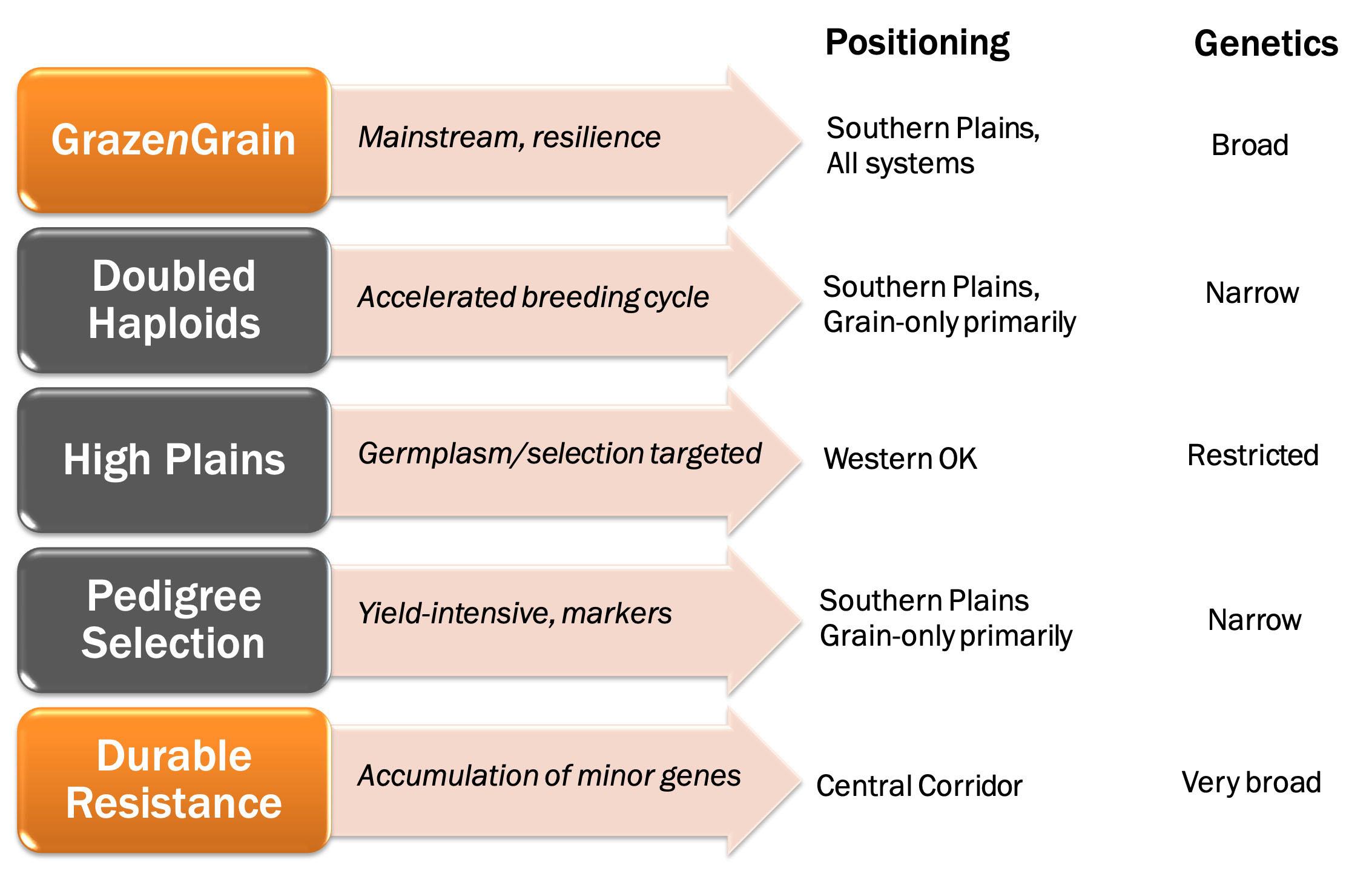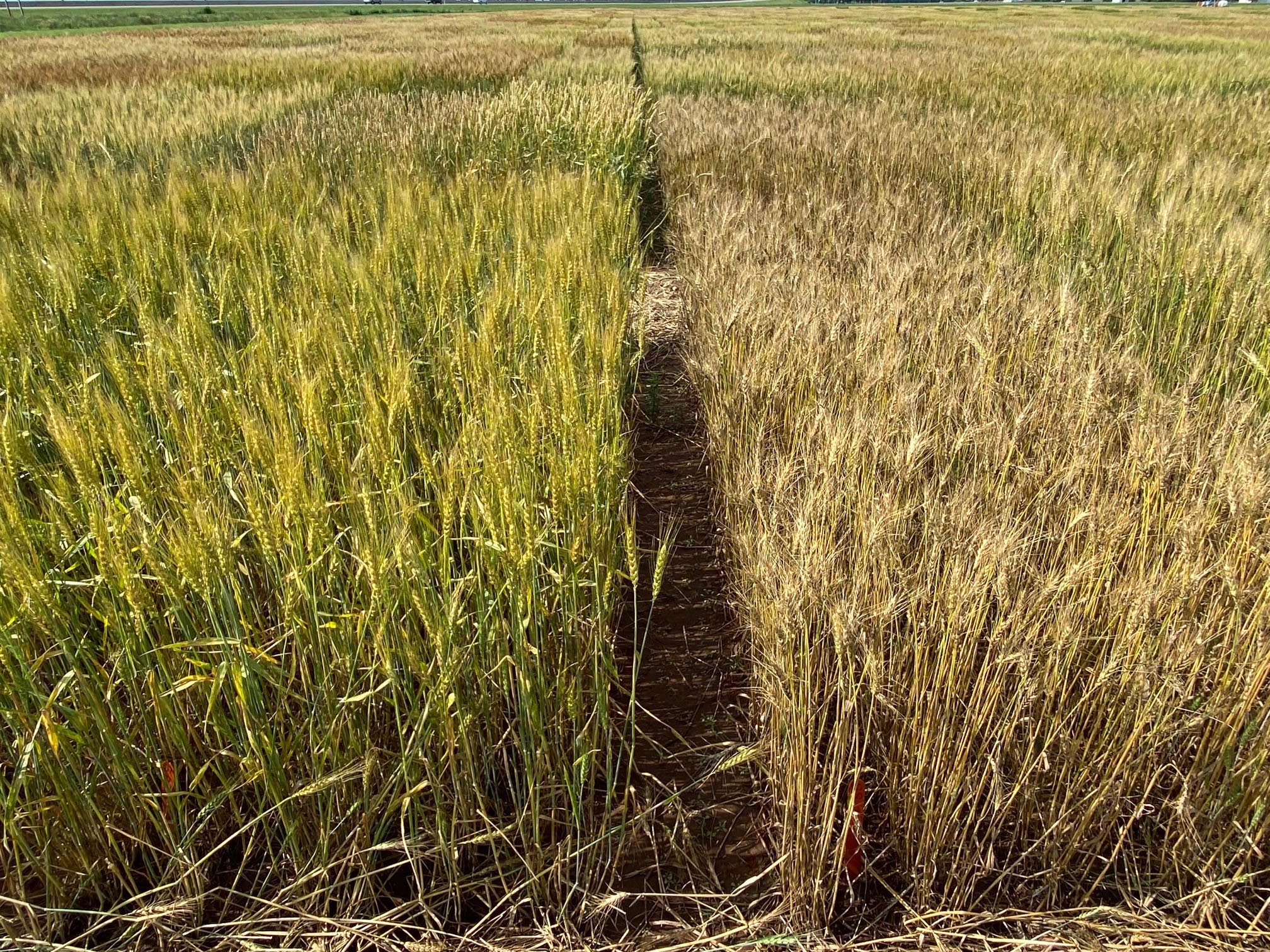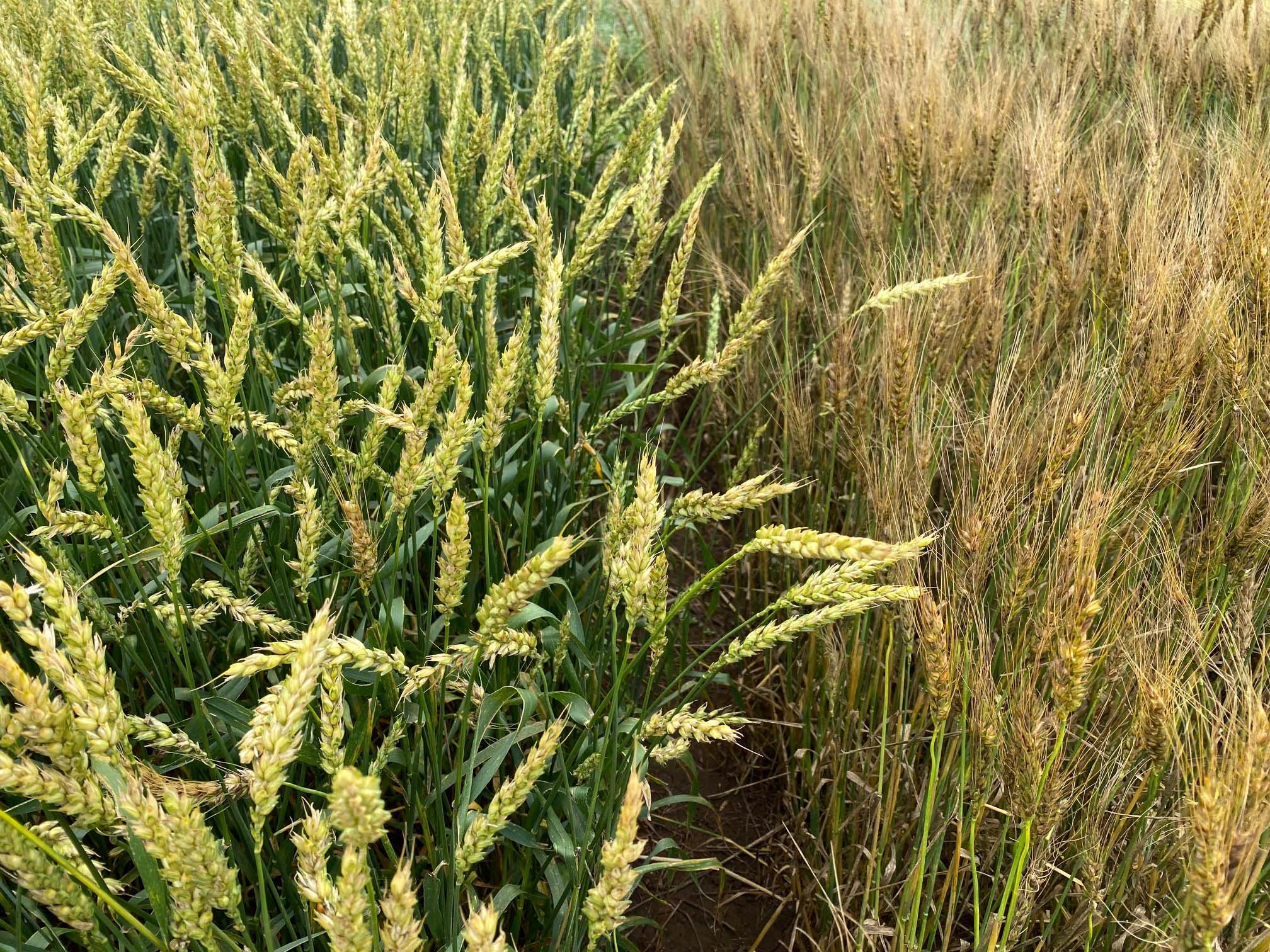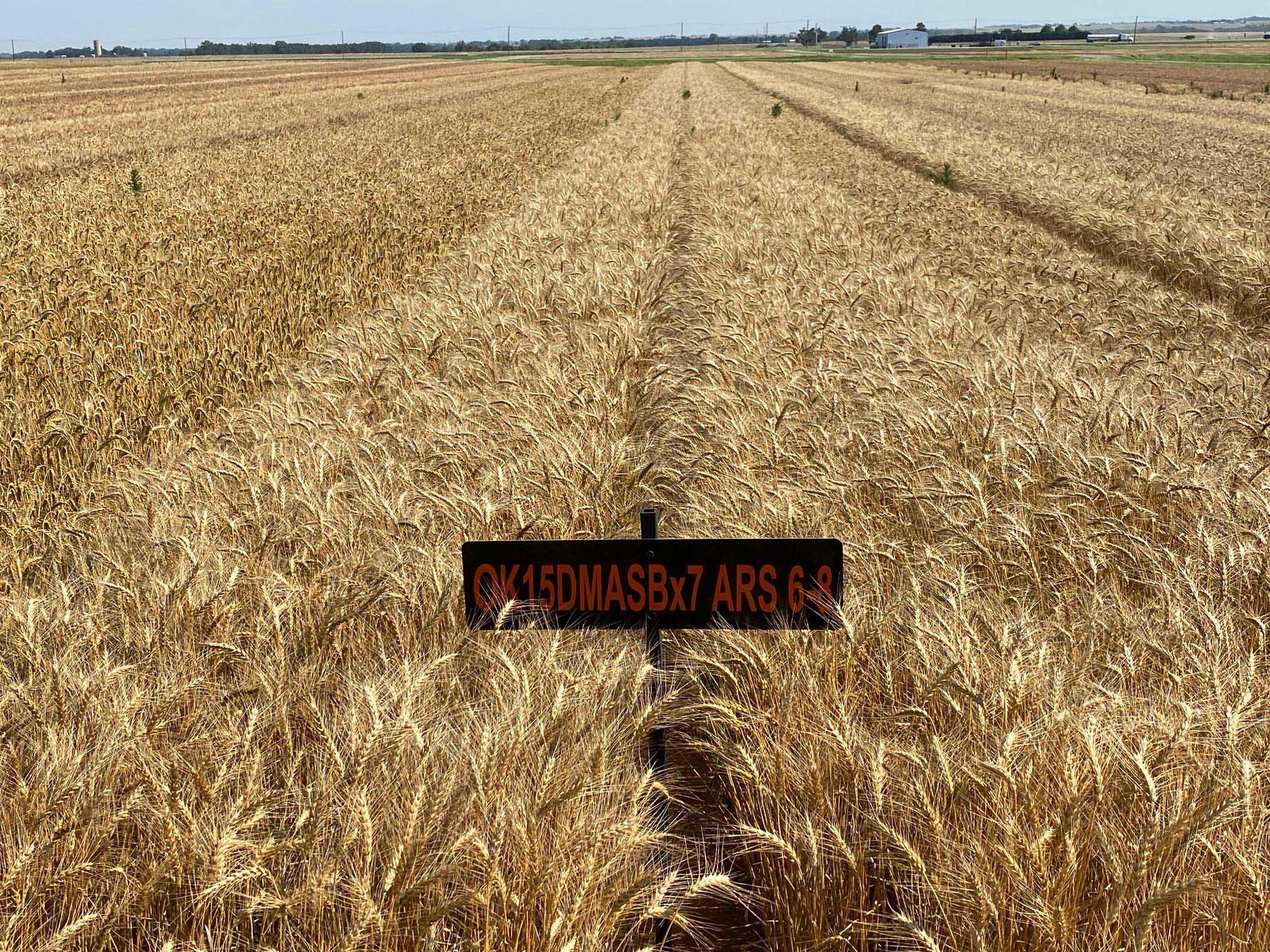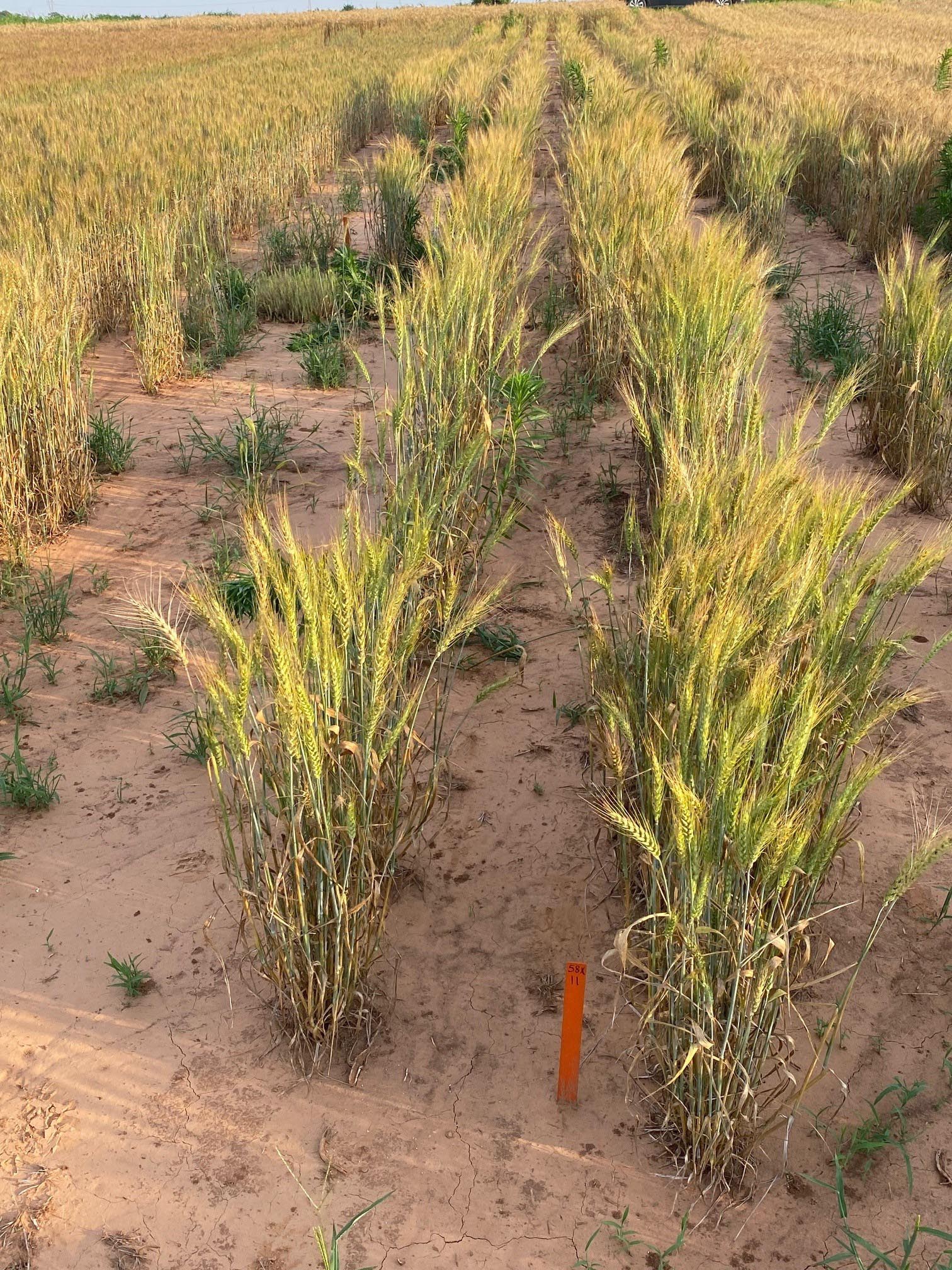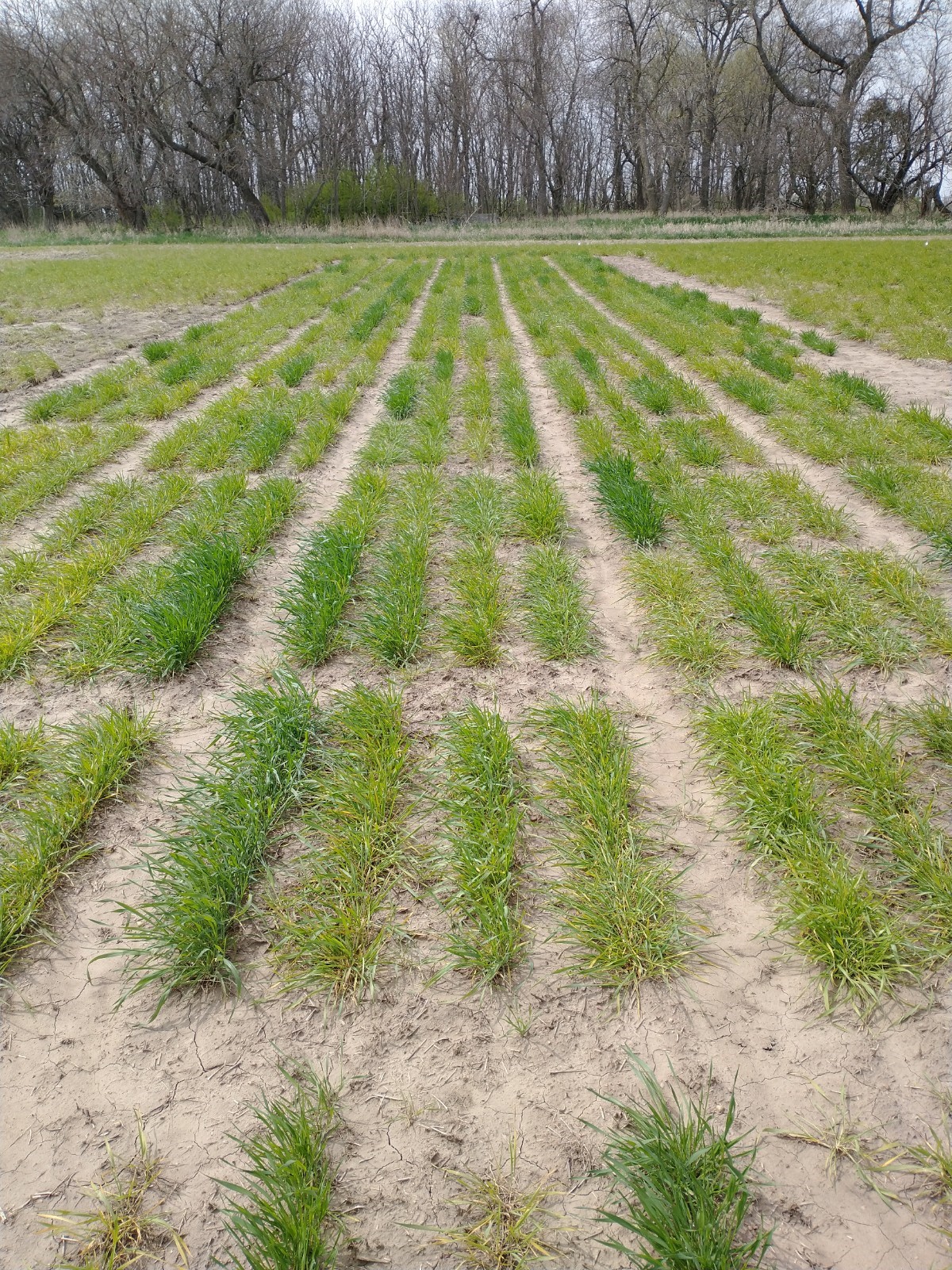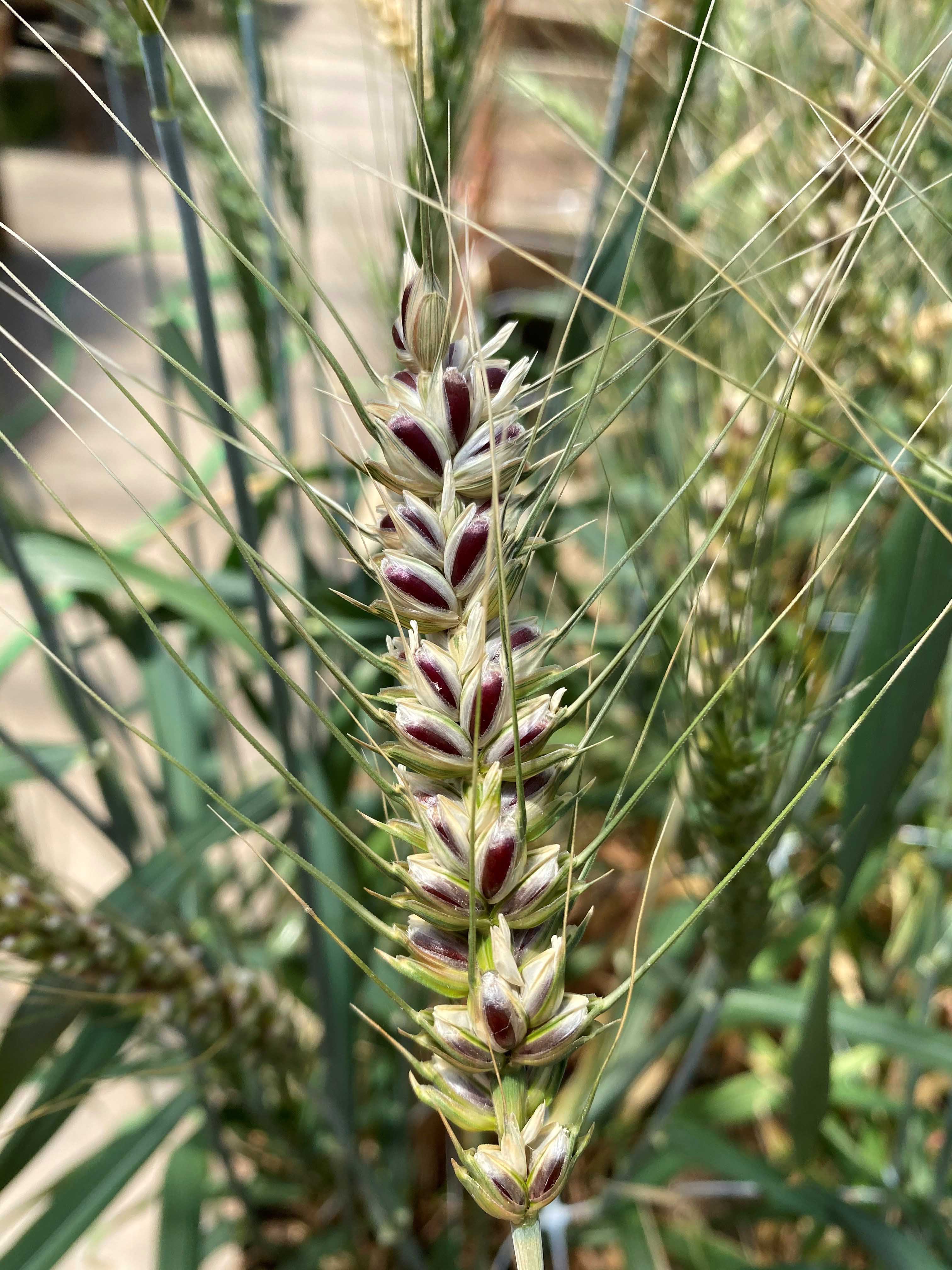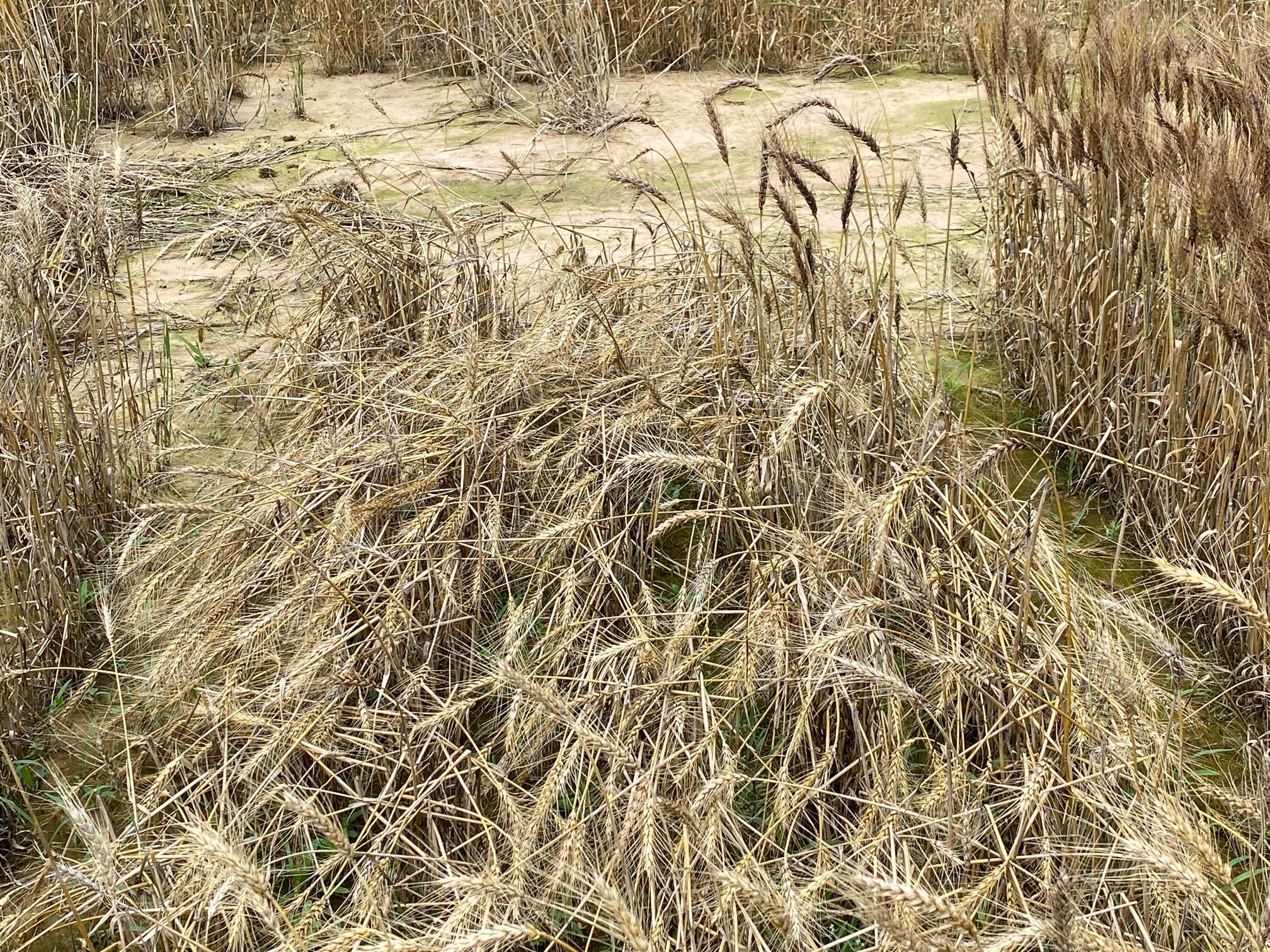Wheat Variety Development 2021
2021 Program Structure
As first illustrated in the 2020 Partners in Progress Wheat Report, the Oklahoma State University (OSU) wheat variety development program (VDP) is now serviced by five genetic pipelines (Figure 1).
Figure 1. The OSU wheat variety development pipeline is actually five pipelines, with more under design or construction. Each pipeline is built from pools of germplasm varying in genetic breadth. Each pipeline produces independent sets of progenies with different adaptation patterns for optimal positioning at the time of release.
A genetic pipeline has three essential design components: a) breeding methodology, or the selection strategy used during the formative early inbreeding generations spanning from the F2-F6 generations (excluding the doubled haploid pipeline), b) the environment(s) in which or the conditions under which experimental line selection occurs prior to line testing, and c) genetic makeup of parental lines used to feed each pipeline.
The Wheat Improvement Team’s strategy of deploying multiple pipelines serves to increase the probability of achieving a certain outcome in the form of a new variety. For example, experimental lines circulating through the GrazenGrain® pipeline are usually, but not always, destined for dual-purpose wheat production. Those from the doubled haploid (DH) pipeline are enabled to shortcut variety development time by about three to four years.
Sixty-nine experimental lines were selected in summer 2021 to represent the most elite germplasm in the OSU VDP. Released varieties for the next one to three years will likely come from this pool, thus the reason for their elite status. The genetic pipeline from which each line originated is identified in Table 1 to underscore the breadth of breeding strategies now employed. No more than 51% of WIT’s elite germplasm originated in a single pipeline, and perhaps surprisingly, only 33% originated in the GrazenGrain pipeline.
The pedigree selection pipeline is credited for far more elite lines than expected in the long-term (Table 1), reflecting the intensity of marker selection over the past decade to achieve outcomes less likely by conventional selection. Such outcomes have involved a) the introgression of barley yellow dwarf resistance (or immunity) from intermediate wheatgrass via a gene named Bdv2, b) the movement of head scab resistance from genetic donors unadapted to Oklahoma, and c) the precise inclusion or exclusion of AHAS genes conferring imazamox tolerance in Clearfield wheat to extend the breeding success of varieties, such as Doublestop CL Plus. Other examples can be cited, but the primary message is that the Pedigree Selection pipeline will settle down over time to yield more lines from the GrazenGrain and DH pipelines.
2021 Program Success
The same 69 elite lines classified in Table 1 by pipeline origin were fully characterized in 2021 for reaction to some of the most challenging diseases in Oklahoma. WIT traditionally relies upon data generated in house, either under natural infection or in a controlled environment (see “Wheat Pathology” report) or externally by collaborators in other wheat-producing states.
2021 was the best year in the past 10 years for comprehensive disease assessment, namely against leaf rust (LR), stripe rust (YR), powdery mildew (PM) and barley yellow dwarf (BYD). Continued selection pressure since 2015 for full genetic protection against one or more of these diseases has produced a vivid shift in canopy health observable in OSU germplasm. Only about 40% of the elite materials emerged from 2016 with highly effective resistance to stripe rust. Today, that percentage stands at 91% (Table 1). Likewise, leaf rust resistance stood at about 50% following the 2017 epidemic. Today, that percentage stands at 87%. Most importantly, about 80% of WIT’s pool of variety-candidate germplasm carries highly effective resistance (fungicide use may not be required) to both leaf rust and stripe rust, an unprecedented level at OSU. Again, this would not have been achieved without the resources devoted within WIT and the collaborations fermented and preserved with other institutions.
How does this frequency of dual YR+LR resistance (80%) compare with contemporary germplasm? One unbiased and representative place to look is the 2021 wheat variety trials directed by WIT member Amanda de Silva. Excluding OSU varieties, the frequency of YR+LR resistance among all public and private varieties tested at Lahoma in 2021 was less than 10%. Among OSU varieties alone, this frequency was 50%.
While PM and BYD have not presented the same nemesis to Oklahoma wheat producers in recent years as have YR and LR, WIT is no less prepared for their existential threat. Among the elite lines, 72% provide highly effective resistance to PM, and 41% provide immunity to BYD, a level of resistance unheard of before the release of Uncharted by OSU in 2020. These protection levels are not that different from current levels offered to Hessian fly or acid soils, two longstanding breeding objectives by WIT.
OSU Wheat Variety Profiling Update
Consistent with expectation, Showdown led all varieties for grain yield in 2021 among a subset selected for uniform variety testing across the central corridor of wheat production in Oklahoma (wheat.okstate.edu). This subset included 14 varieties, only six from OSU. Hence, Showdown is doing exactly what it did for six years before its release in 2018 – win yield trials. However, do not expect Showdown to have a high-yielding year if moderately or severely infected with leaf rust (not stripe rust) at any point from March to May. Showdown will benefit from fungicide application in that case.
WIT was extremely active in 2020 for bringing new varieties to a launch point. Factors leading to such a high number of releases were rare and coincidental. Four of the five pipelines produced commercial-ready germplasm at the same time after having been subjected to statewide testing for a highly variable number of years. The five varieties released in 2020 are positioned in disparate and highly targeted ways: early planted grazed systems (Uncharted), the Clearfield management system (Strad CL+), panhandle production in the presence of wheat streak mosaic (Breakthrough), late-planted scenarios (Butler’s Gold) and white wheat production likely to be contracted (Big Country). Their differences are profiled in Figure 2 (updated for this report), along with varieties released in 2018 and 2019.
As mentioned in the previous section, OSU wheat varieties carry a fortified genetic package of disease resistance traits. This enables wheat producers to capitalize on innate canopy hygiene to reduce, if not minimize, fungicide dependency. Varieties that fall into this classification are Doublestop CL Plus, Strad CL Plus, Green Hammer, Skydance, Uncharted, Big Country and Butler’s Gold. This trend will only be strengthened based on the elite lines stocked in the pipelines primed for release.
Figure 2. Trait profiles for all OSU wheat varieties released since 2018.
Oklahoma Foundation Seed Increase
Following the 2021 harvest and after thorough consideration of all advanced lines under breeder-seed increase in 2021, 17 new HRW candidates were placed under grow-out and on-farm evaluation by Oklahoma Foundation Seed Stocks in 2021-22. These candidates feature a Doublestop persona with or without imazamox herbicide tolerance, an elevated level of dough strength comparable to or exceeding spring bread wheat, head scab resistance and high yield and quality with broad utility (Table 3).
2021 Photo-Highlights
Figure 3. More than 2,200 doubled haploids were evaluated in 2021 across Oklahoma, including this site near Chickasha, which was severely impacted by stripe rust and moderately impacted by leaf rust following a damaging freeze event in April. About 600 of these progenies were advanced for further testing and selection in 2021-22. The crosses from which these DHs originated were completed in 2017. The possibility exists to recommend one of these progenies for release as early as fall 2023, only six years after the cross. Photo taken May 28, 2021.
Figure 4. Contrast in stripe rust resistance resident to this breeding program. Photo taken May 26, 2021, at Chickasha. Big Country, left; Ruby Lee, right.
Figure 5. One of three candidate varieties featuring exceptionally high mixing tolerance and dough strength, OK15DMASBx7 ARS 6-8, also provides top-tier yields throughout the central wheat corridor of Oklahoma, with its center of adaptation in southwest and central Oklahoma. Commercialization of OK15DMASBx7 ARS 6-8 will likely take a value-capture path unique from prior releases, whereby grain production is contracted for direct shipment to major flour processing centers in the U.S. and Mexico.
Figure 6. WIT’s first breeding nursery dedicated to selection of AXigen resistance to quizalofop, an acetyl coenzyme A carboxylase-inhibiting herbicide at Lahoma in 2021. More than 4,000 progenies were selected in 2021 from survivor headrows at this location, and these in turn will be selected for the AXigen and other Oklahoma-relevant traits in 2022. Sister selections are concurrently funneled through the DH pipeline for seed increase in Yuma, Arizona.
Figure 7. OK Corral will not be WIT’s last shootout with beardless wheat. Several experimental lines will make their way through the VDP in the next two to three years, including OK21227 (MD01W233-06-1/Gallagher//OK13216), which is shown on the right at Tipton in the midst of a severe stripe rust epidemic. Photo taken May 3, 2021.
Figure 8. Selection by WIT for wheat streak mosaic (WSM) and Triticum mosaic (TrM) resistance is accomplished by genetic markers and then validated with phenotypic screening in field inoculated nurseries near Mead, Nebraska, in cooperation with the University of Nebraska – Lincoln. Mid-generation WIT lines with strong dual resistance to WSM and TrM were found in this nursery in 2021, and those will be elevated to elite status pending performance in 2022 breeder nurseries. This germplasm is expected to soon provide alternatives or replacements for Breakthrough, released by the Oklahoma Agricultural Experiment Station in 2020.
Figure 9. In cooperation with OSU’s Department of Nutritional Sciences, and with research conducted by OSU undergraduate and Wentz Scholar Georgia Eastham, WIT is currently evaluating commercial-ready germplasm with purple brancoat that would add value to Oklahoma’s wheat crop for use in food products that emphasize naturally elevated antioxidant capacity. Photo taken April 30, 2021, in OSU’s greenhouse complex at the Agronomy Research Station in Stillwater.
Figure 10. A mature straw condition called brackling was highly evident at Perkins in 2021. Selection against this condition is applied when the opportunity arises as it did in 2021. Differences in expression were extreme at this site, reflecting a strong genetic component. Resistance to brackling is not associated with acid-soil tolerance, but the lone plant standing in this severely brackled plot was a volunteer Doublestop CL Plus plant (brackling resistant).

